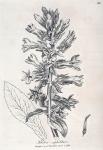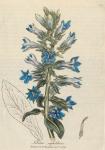
 Synonyma. Lobelia. Pharm. Edinb.
Synonyma. Lobelia. Pharm. Edinb.
Rapunculus Americanus, flore dilute caruleo. D. Dodart Memoires, &c. p. 297.
Rapunculus galeatus virginianus, flore violaceo majore. Morrison Hist. t. ii. p. 466.
Lobelia siphilitica caule erecto laevi, foliis lato lanceolatis serratis incisis utrinque acuminatis, floribus caeruleis. Walter Flora Carolin. p. 218.
Conf. Kalmii descriptio largior in K. Vet. Acad. Handl. p. 284. and Bartrams Appendix , containing descriptions, virtues, and uses of sundry plants, &c.
Class Syngenesia. Ord. Monogamia. Lin. Gen. Plant. 1006.
Ess. Gen. Ch. Cal. 5-fidus. Corolla 1-petala, irregularis. Capsula infera, 2—s. 3-locularis.
Spec. Char. Caule erecto, foliis ovato-lanceolatis subserratis, calycum sinubus reflexis.
The root is perennial, and furnished with many white fibres: the stem is upright, strong, simple, smooth, and rises upwards of two feet in height: the leaves placed towards the top of the stem, are oval and pointed; those at the bottom are elliptical, and obtusely lance-shaped; they are both minutely serrated, veined, smooth, and without footstalks: the flowers are numerous, large, blue, and grow in a long spike, upon short peduncles: the corolla consists of a long tube, which is nearly cylindrical, and divided at the limb into live pointed oval segments, of a rich blue colour: the calyx is composed of five halberd-shaped leaves, which are fringed at the margin, and reflected at each side: the filaments are five, tapering, equal in length to the tube of the corolla, and closely connected at the top by the antherae: the germen is short and conical; the style is of the length of the stamina, and terminated by a blunt hairy stigma: the capsule is oval, and divided into two cells, which contain many small seeds. It is a native of Virginia, and flowers from August till October.
Rea is the first English botanist to whom Mr. Aiton ascribes the cultivation of this species of the Lobelia, and, as a handsome plant, it is now in the possession of many of our gardeners. Every part of the plant abounds with a milky juice, and has a rank smell. The root, which is the part directed for medicinal use, in taste resembles tobacco, and is apt to excite vomiting. It derived the name siphilitica from its efficacy in the cure of syphilis, as experienced by the North American Indians, who considered it a specific in that disease, and with whom it was long an important secret. This secret was purchased by Sir William Johnson, and since published by different authors. [Kalm. l. c. Bartram. l. c.]
The method of employing this medicine is stated as follows: A decoction is made of a handful of the roots in three measures of water. Of this, half a measure is taken in the morning fasting, and repeated in the evening; and the dose is gradually increased till its purgative effects become too violent, when the decoction is to be intermitted for a day or two, and then renewed till a perfect cure is effected. During the use of this medicine, a proper regimen is to be enjoined, and the ulcers are also to be frequently washed with the decoction, or if deep and foul, to be sprinkled with the powder of the inner bark of the New Jersey Tea-tree (Ceanothus Americanus.) Although the plant thus used is said to cure the disease in a very short time, yet we do not find that the antisyphilitic powers of the Lobelia have been confirmed by any instances of European practice.

